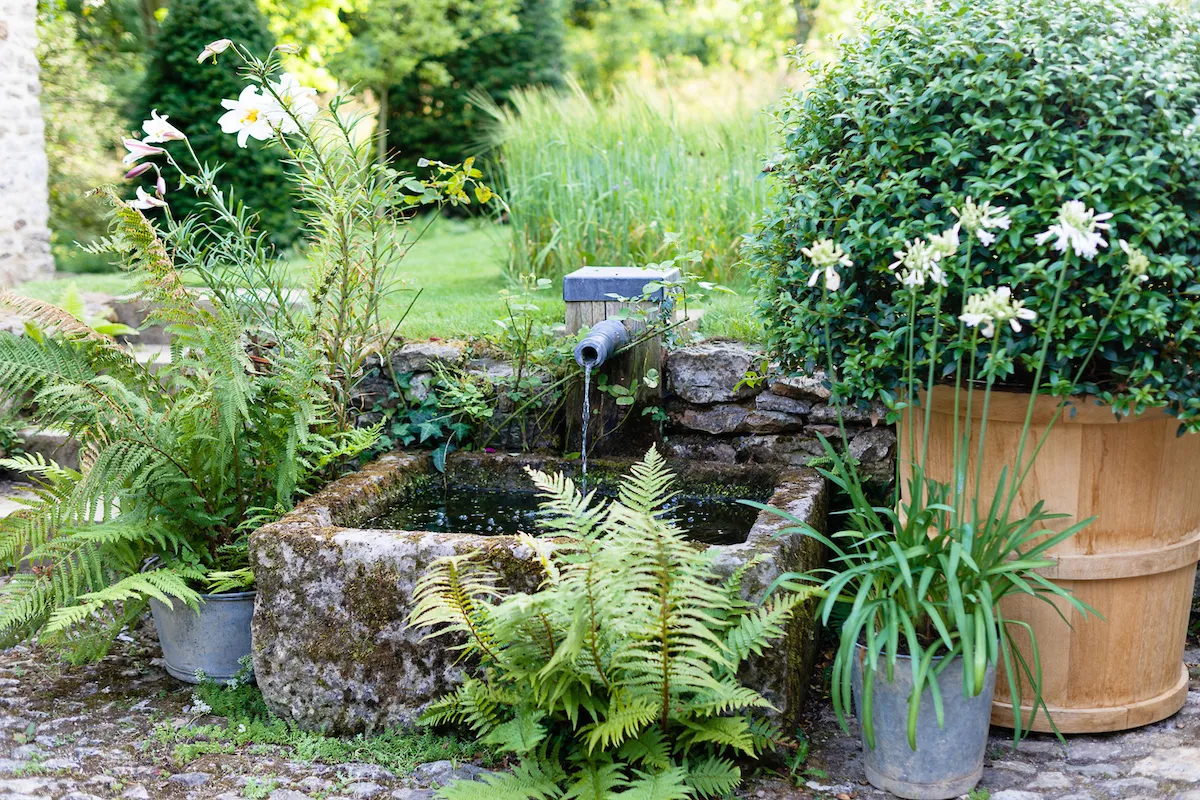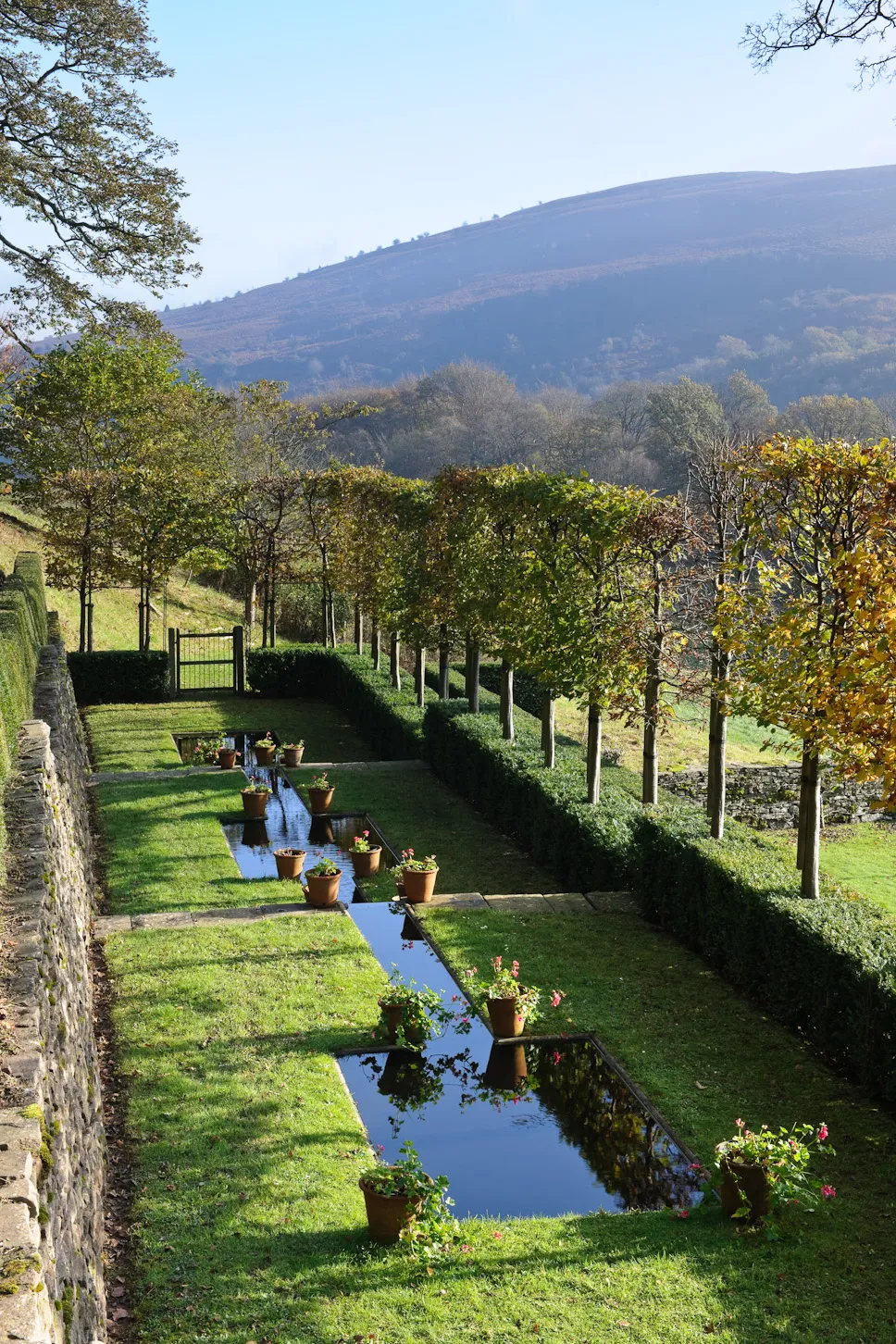The water feature is a rather generic term that covers a wide range of ways to use water in the garden. We dealt with ponds and pools in another article (click here to read) but apart from this relatively simple use of water, there are other more dynamic and exciting options.
Fewer people have the space for ponds or standing water of any kind and maintaining pools can be time-consuming, too, especially those that are planted. Many other water features, though, are easy to look after, and ornament the garden with a playful splash or a glittering cascade.
Popular water features

Probably the most popular water feature in smaller gardens is a wall-mounted spout above a basin. A small submersible pump circulates the water, and relatively little is used. Plumbing is best hidden behind the wall, which is something people often overlook when they plan to locate a spout on a boundary wall. In these cases the pipe work may be tucked into a recessed channel in the wall or simply masked with climbing plants. It may also be possible to create a false wall behind which the plumbing can be enclosed.
Hiding water features away until you need them improves the flexibility of your garden. Fountains fed by underground water tanks can be almost invisible until they burst into life with the flick of a switch. A commonly used system is based on a fibreglass or GRP (glass reinforced plastic) tank and submersible pump. The tank is often covered with mesh capable of holding gravel and cobbles. A variety of nozzles can be attached to the fountain pump to create anything from frothing jets to hemispheres of film-like water. The main practical issue is the connection to the mains for the pump, although recent advances in solar technology mean that these relatively modest features can be self-sufficient.

Sinking the water below ground keeps it out of the sun, so it’s less likely to warm up and evaporate. The tank will still need an overflow facility but topping up the level is much less demanding.
More sophisticated versions of these simple devices can be introduced either for children to play in or to create dramatic jets that erupt from paved surfaces. These are often seen now in public spaces, but can be downsized for the domestic garden. Drainage channels need to be designed into the paving to re-direct the excess water back into the underground tank. One major design consideration to take into account is the effect of wind – the higher the jet, the more tricky this can be.
A fountain located in the centre of a pool in a sheltered location should propel water no higher than half the width of the pool. By contrast, in windier locations, the jet should reach a height no more than a quarter of the pool’s width. If a fountain is playing on to paved areas, the same rule governs the area that should be properly drained.
Reflective surfaces

Reflections can be used to good effect in smaller water features. The polished finish of stainless steel has been popular with designers of water features and can easily be formed into a holding tank, within which the pump is located. The water simply overflows the top edge and slips down the polished surface, held by surface tension and the speed of the water flow. The rippling patterns catch the eye and create a soothing, quiet sense of rhythmic movement.
The steel can be worked into many different forms, but generally these features work best when the top edge is above normal eye level, hiding the inner mechanisms. Trickery in construction often produces successful features.
The same technique can be used with stone, brick, ceramics or concrete, and here the water reservoir is built into the fabric of a wall, for example, like a box filled with water. The internal surfaces should be waterproofed with butyl or fibreglass. A lip of stainless steel or aluminium along one lower edge of the reservoir will allow water to cascade over the surface of the wall before being caught either in a pool or hidden tank and re-circulated.
These larger cascades can create an incredibly dramatic setting in a garden, recreating the sound of a waterfall and revitalising the air. In urban gardens the use of water to create sound in this way is invaluable in drowning out the annoyingly persistent, ambient noise of traffic and aircraft. The more uneven the surface of the feature, the more spectacular the results can be.
Bold reflections

Creating a film of running water over stone or concrete enhances reflections and can bring out the grains and patterns of different materials. Emphasise reflections with dark materials such as slate, black granite, basalt or black stainless steel. Water can be pumped up from a reservoir to flood across their surfaces. Eventually the water flows over the edge to be returned to the reservoir below.
Water could also fall in a cascade at one end of the slab or block, rippling across the surface to create movement and catch the light. This reduces the amount of water required to produce a reflective surface by comparison with a reflective pool or pond. LED or optic-fibre lighting can also be used to create surfaces that can still be a focal point after dark.
Sculptors such as William Pye have turned the interaction between water and materials into a fine art, using reflective surfaces and moving jets with steel and bronze, clear acrylic or stone. Andrew Ewing is famed for his bespoke, sophisticated water features for any size of garden and many designers specialise in the inclusion of water within their garden commissions. Water remains a sought-after focus for many garden owners, although it is essential to acknowledge the ongoing need for regular maintenance and cleaning throughout the life of these features.
KEY POINTS TO TAKE AWAY
- With larger features, locate the pump and reservoir in a separate underground chamber that can be reached through an inspection cover to make maintenance easier. If the cover is located in paving, use recessed lids, designed to take the paved surface to render the cover ‘invisible’.
- In hard water areas the pH of the water should be neutralised to prevent limescale building up on the surfaces of the water feature.
- Consider using disinfectants to kill algae in the water. Bromine and chlorine are the most common chemicals used, partly for their ease of application and because they remain within the water over a period of time. Consult a water feature specialist. Legionella is also of concern, especially with misted or sprayed water. This bacterium can also be controlled in this way. UV light provides an alternative method of control, although the residual qualities of bromine or chlorine provide greater assurance. The additives won’t be harmful on contact with treated water.
- In the case of cascades or fountain jets, consider wind conditions. Wind can blow water from jets and cascades out of a receiving pool, causing water loss from the system and potential damage and staining to surfaces.
- Clear materials such as glass or Perspex (acrylic) will need additional cleaning and maintenance as they rely on transparency for their impact. Staining and scaling will be most noticeable with these materials, especially when the system is switched off.
Useful websites
- A gallery of water sculptor William Pye’s works for large-scale public and small-scale domestic spaces
- Domestic scale water features hand-crafted by sculptor Lucy Smith in glazed clay www.lucysmith.org.uk
- Advice, design support and maintenance of a wide range of water features. www.fairwater.co.uk
Words Andrew Wilson. Andrew is a garden designer, writer and lecturer, and an assessor and judge for RHS Show Gardens.
